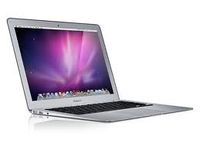Draft:Setting up your new Mac Air
About this article
This article provides a checklist for you to consider as you finish setting your new Mac laptop so that you are work functional. It is intended for all students and employees participating in the E-Warrior Digital Life and Learning Program. While you complete the following checklist as you configure your laptop it may helpful to refer back to the New laptop and table features article as it highlights some of the important changes found on your new laptop.
Frequently asked questions
Why do you have to configure my laptop? Where are all my software applications? Where can you get help? If you have questions, check our Frequently Asked Questions article for answers.
Set up and get to know your MacBook
After your laptop distribution session you will need to make a few configurations to be work functional.
Everyone - Review Hardware
Review what's new on your MacBook Air
Review the hardware features of your new Apple MacBook Air
Getting the most out of your battery
Introduction to the MacBook Air keyboard
Everyone - Where to begin with Yosemite on your new MacBook Air
Lynda.com video on the New Features of Yosemite
Everyone - Adding software
The following items cover what software is pre-loaded on your laptop and how to find additional software you may wish to use as a part of the E-Warrior Digital Life and Learning Program.
Pre-loaded software on the MacBook Air. You can check this list before loading any new software to the laptop.
Installing software from the network. Many unique or discipline specific software applications can be installed on your laptop (e.g. Adobe Acrobat XI Pro, Inspiration, Maple, Mathmatica, SPSS).
Installing software from the Mac OS X App Store. Programs such as iPhoto, iMovie, and Garageband are now optional applications that users can load based on their need and this article explains the process of installing these apps from the Apple App Store.
Everyone - File Storage
The Mac Air has a 256 GB hard drive. Since hard drives crash and can get viruses, it is best practice to only store data there that you can do without if your system crashed. The use of network and cloud storage is recommended because it is backed up nightly.
Network and Cloud Storage Comparison
OneDrive for Business is cloud based storage for employees and students.
Local network storage refers to space, on networked servers located on the Winona campus and administered by WSU staff, reserved for employees to use to store their files. WSU maintains several servers intended for the local storage of employee files. These include network drives, OneDrive for Business, Web Storage and Class Storage.
Optional - Finding a printer
Locating the networked or personal printer you wish to use can be found in the following two items.
Optional - Connecting to the network from off campus
To access WSU network drives, printers and certain web-based software from off campus you must establish a virtual private network (VPN) connection. We use Cisco AnyConnect to connect to the WSU nework from off campus.
The network drives require running the Map network drive script after you have connected via VPN.
Optional - Digital Security
Addressing security threats and managing risk is a vital part of our eWarrior program and extensive documentation can be found here to educate yourself on the many measures that can be taken to prevent data breaches or spread of harmful viruses and malware.
Information Security siteWSU's digital security information and policies that are perjtinent to WSU employees.
Know where to store your data. This is a site that explains the different types of data you may have access to and the appropriate spaces where these data should be stored.
Know your data. This link takes you directly to our site on governing laws and policies that relate to data.
What is Private Data? This article provides a quick summary of private data and how employees should protect this information.
What is Malware? This article on malware is intended to provide you answers to this question and ways for you to prevent it from infecting your laptop.
What is Phishing? Another important topic to read up on so you can prevent your data from becoming exposed by phishing.
Locking your laptop screen is one security measure everyone is guilty of forgetting to do. Remember: The easy way to lock your laptop is with the Windows key and L.
Using KeePass will allow you to easily store your passwords in an encrypted database.
Take a workshop on Digital Security. These workshops are offered each semester, but if there are no workshops listed, you can Request a Workshop.
Optional - Trackpad settings
The Mac trackpad has many gestures setup to use with it. The video below provides an overview these gestures. You can also go to Settings and select the Trackpad icon to change the default settings.
Unsupported applications
If you installed any unsupported software for school or personal use such as a password vault, a citation manager (e.g., EndNote, Reference Manager), a tax preparation tool (e.g., TurboTax), or photo gallery software, back up any related files you wish to retain. Consult your documentation to determine the location and format of these files. TLT (tlt@winona.edu) will provide limited support if you have questions, but your first line of support is the vendor.
How to get additional training
Workshops and 1:1's
Faculty and staff are welcome to stop drop in or call TLT (Maxwell 130, ext. x5240 option 2) for 1:1 support or sign up for workshops at TLT Faculty-Staff signup.
Students can stop in at Somsen 207 for DLC STAR support.
Lynda
Need help with software, try Lynda online tutorials. With a Lynda account you will have access to over 2000 videos. Learn how to create your account profile by going to Lynda for instructions.
